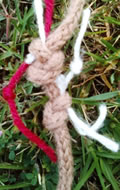
Þlaéhl [θlaˈe:hl] was devised by Anthony Hilton to write his invented language Чlalmwae [ʈlalˈmwa:e] with a series of knots in cords. It was inspired by the quipu or khipu, an ancient record-keeping system based on knotted chords that was used by Andean peoples such as the Inca in South America from the 3rd millennium BC until about the 17th century AD. It is part of a larger world construction project that Anthony has been working on since 2011.
In Þlaéhl vowels are primary and consonants are secondary, unlike writing systems such as abjads and abugidas, which make consonants primary.
A knot is a vowel: the center of a syllable.
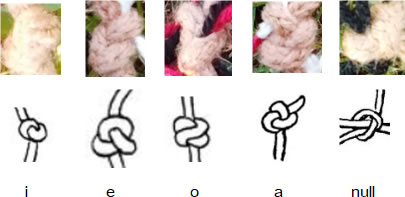
Knot drawings from The Ashley Book Of Knots by Clifford W Ashley
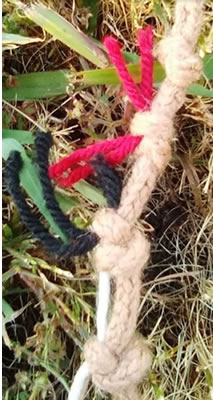
Vowel knots are normally tied to the cord moves leftward, “S-orientation.”
Pictured, a word ‘itemoya,' selected because it features the four vowels in “alphabetical” order. (Trivially, it means ‘to inhere.') The noose, not pictured here, is very easy to spot. See it as the top-left most knot in the Article 1 picture.
One reads each line of knots downward.
It may actually be easier to feel than to see the differences in the knots, though the visual learning curve doesn't take long.
Colored piles (short strands of yarn), tied into the vowels, indicate consonants.
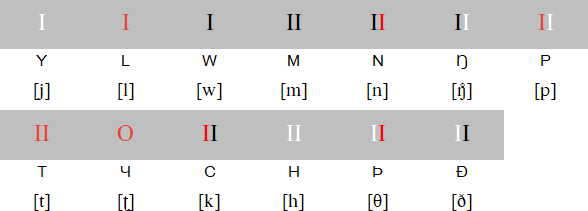
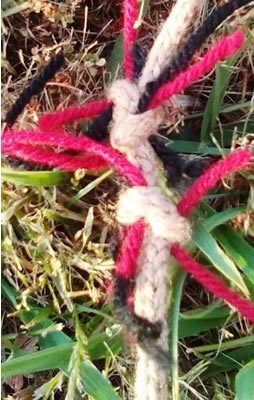
The picture above shows the word ‘concwel,' ‘to thank, to attempt to deserve.' With the two left consonants (both II: c), the red is higher than the black. In the top right consonant, (II: n) the black is higher. In the lower left consonant (still c), the two piles are tied together, spelling cw-. See below.
Knots in piles indicate the only three consonant blends.
Texts often wrap around a frame; knots don't go in books or scrolls. One usually reads with one's hands and eyes both, especially to hold cords straight.
Each line tends to the same total of spaces and syllables.
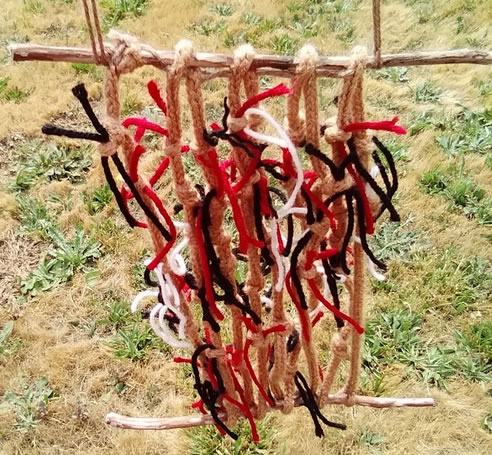
![]()
All human beings are born free and equal in dignity and rights. They
are endowed with reason and conscience and should act towards one another in a spirit of brotherhood.
(Article 1 of the Universal Declaration of Human Rights)
If you have any questions about this script, or other scripts invented by Anthony Hilton, you can contact him at: 831ACH[at]gmail[dot]com
Constructed scripts for: Ainu | Arabic | Chinese languages | Dutch | English | Hawaiian | Hungarian | Japanese | Korean | Lingala | Malay & Indonesian | Persian | Tagalog / Filipino | Russian | Sanskrit | Spanish | Taino | Turkish | Vietnamese | Welsh | Other natural languages | Colour-based scripts | Tactile scripts | Phonetic/universal scripts | Constructed scripts for constructed languages | Adaptations of existing alphabets | Fictional alphabets | Magical alphabets | A-Z index | How to submit a constructed script
[top]
You can support this site by Buying Me A Coffee, and if you like what you see on this page, you can use the buttons below to share it with people you know.

If you like this site and find it useful, you can support it by making a donation via PayPal or Patreon, or by contributing in other ways. Omniglot is how I make my living.
Note: all links on this site to Amazon.com, Amazon.co.uk
and Amazon.fr
are affiliate links. This means I earn a commission if you click on any of them and buy something. So by clicking on these links you can help to support this site.
[top]